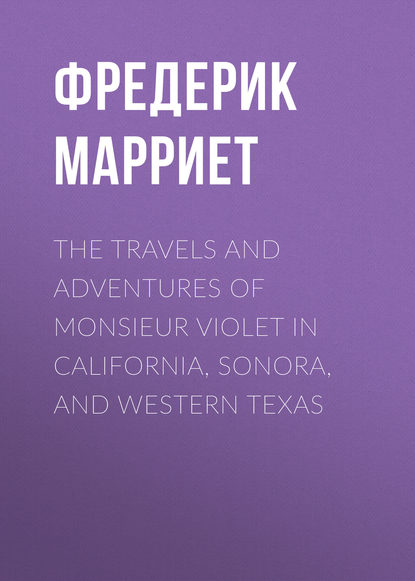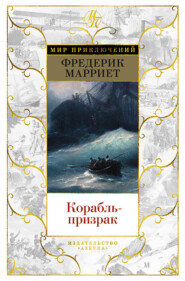По всем вопросам обращайтесь на: info@litportal.ru
(©) 2003-2025.
✖
The Travels and Adventures of Monsieur Violet in California, Sonora, and Western Texas
Автор
Год написания книги
2018
Настройки чтения
Размер шрифта
Высота строк
Поля
It would appear that, even among animals, where there is a society, there is a tyrant and paria. On board vessels, in a school, or any where, if man is confined in space, there will always be some one lording over the others, either by his mere brutal strength or by his character; and, as a consequence, there is also another, who is spurned, kicked, and beaten by his companions, a poor outcast, whom everybody delights in insulting and trampling upon; it is the same among gregarious brutes. Take a flock of buffaloes or horses, or of antelopes; the first glance is always sufficient to detect the two contrasts. Two of the animals will stand apart from the herd, one proudly looking about, the other timid and cast down; and every minute some will leave their grazing, go and show submission, and give a caress to the one, and a kick or a bite to the other.
Such scenes I have often observed, and I have also witnessed the consequence, which is, that the outcast eventually commits suicide, another crime supposed to be practised only by reasoning creatures like ourselves. I have seen horses, when tired of their prairie life, walk round and round large trees, as if to ascertain the degree of hardness required; they have then measured their distance, and darting with furious speed against it, fractured their skull, and thus got rid of life and oppression.
I remember a particular instance; it was at the settlement. I was yet a boy, and during the hotter hours of the day, I used to take my books and go with one of the missionaries to study near a torrent, under the cool shade of a magnolia.
All the trees around us were filled with numerous republics of squirrels, scampering and jumping from branch to branch, and, forgetful of everything else, we would sometimes watch their sport for hours together. Among them we had remarked one, who kept solitary between the stems of an absynth shrub, not ten yards from our usual station. There he would lie motionless for hours basking in the sun, till some other squirrels would perceive him. Then they would jump upon him, biting and scratching till they were tired, and the poor animal would offer no resistance, and only give way to his grief by plaintive cries.
At this sight, the good padre did not lose the opportunity to inculcate a lesson, and after he had finished speaking, he would strike his hands together to terrify the assailants.
"Yes," observed I, using his own words, "it is nature."
"Alas! no," he would reply; "'tis too horrible to be nature; it is only one of the numerous evils generated from society." The padre was a great philosopher, and he was right.
One day, while we were watching this paria of a squirrel, we detected a young one slowly creeping through the adjoining shrubs; he had in his mouth a ripe fruit, a parcimon, if I remember right. At every moment he would stop and look as if he were watched, just as if he feared detection. At last he arrived near the paria, and deposited before him his offering to misery and old age.
We watched this spectacle with feelings which I could not describe; there was such a show of meek gratitude in the one and happiness in the other, just as if he enjoyed his good action. They were, however, perceived by the other squirrels, who sprang by dozens upon them; the young one with two bounds escaped, the other submitted to his fate. I rose, all the squirrels vanished except the victim; but that time, contrary to his habits, he left the shrub and slowly advanced to the bank of the river, and ascended a tree. A minute afterwards we observed him at the very extremity of a branch projecting over the rapid waters, and we heard his plaintive shriek. It was his farewell to life and misery; he leaped into the middle of the current, which in a moment carried him to the shallow water a little below.
In spite of his old age, the padre waded into the stream and rescued the suicide. I took it home with me, fed it well, and in a short time its hair had grown again thick and glossy. Although left quite free, the poor animal never attempted to escape to the woods, and he had become so tame, that every time I mounted my horse, he would jump upon me and accompany me on my distant excursions. Eight or ten months afterwards he was killed by a rattle-snake, who surprised him sleeping upon my blanket, during one of our encampments.
THE END
notes
1
Indians living on the Columbian river, two hundred miles above Fort Vancouver, allied to the Nez Percés, and great supporters of the Americans.
2
Name given to the half-breeds by the Spaniards, but by Indians comprehending the whole Mexican race.
3
The "spirit of the young beaver;" a name given to me when I was made a warrior.
4
Two priests, literally two black gowns.
5
When a chief wishes to go to war, he sends to his warriors some leaves of tobacco covered with vermilion. It is a sign that they must soon be prepared.
6
The American travellers (even Mr. Catlin, who is generally correct) have entirely mistaken the country inhabited by the Shoshones. One of them represents this tribe as "the Indians who inhabit that part of the Rocky Mountains which lies on the Grand and Green River branches of the Colorado of the West, the valley of Great Bear River, and the hospitable shores of the Great Salt Lakes." It is a great error. That the Shoshones may have been seen in the above-mentioned places is likely enough, as they are a great nation, and often send expeditions very far from their homes; but their own country lies, as I have said, betwixt the Pacific Ocean and the 116th degree of west longitude. As to the "hospitable" shores of the Great Salt Lake. I don't know what it means, unless it be a modern Yankee expression for a tract of horrid swamps with deadly effluvia, tenanted by millions of snakes and other "such hospitable reptiles." The lake is situated on the western country of the Crows, and I doubt if it has ever been visited by any Shoshone.
7
Horses were unknown until the arrival of the Spaniards.
8
Skeletons of the mammoth are often found whole at the foot of the Grand Serpent, a long rugged mountain which runs for 360 miles under the parallel of 40 degrees north latitude. It extends from the centre of the Shoshone territory to the very country of the Crows, that is to say, from the 119th to the 113th degree west longitude. It is possible that this race may not have been yet quite extinct in the middle of the 17th century; for, indeed, in their family records, aged warriors will often speak of awful encounters, in which their great-great-grandfathers had fought against the monster. Some of them have still in their possession, among other trophies of days gone by, teeth and bones highly polished, which belong indubitably to this animal, of which so little is known. Mr. Ross Cox, in the relation of his travels across the Rocky Mountains, says, "that the Upper Crees, a tribe who inhabit the country in the vicinity of the Athabasca river, have a curious tradition with respect to these animals They allege 'that these animals were of frightful magnitude, that they formerly lived in the plains, a great distance in the south, where they had destroyed all the game, after which they retired to the mountains. They killed everything, and if their agility had been equal to their size and ferocity, they would have destroyed all the Indians. One man asserted that his great-grandfather told him he saw one of those animals in a mountain pass, where he was hunting, and that on hearing its roar, which he compared to loud thunder, the sight almost left his eyes, and his heart became as small as that of a child's.'"
9
A few miles from the Pacific Ocean, and at the foot of a mountain called by the Shoshones the Dwelling of the Monster, were found the remains of an immense lizard belonging to an extinct family of the saurian species. Within a few inches of the surface, and buried in a bed of shells and petrified fish, our old missionary, Padre Antonio, digged up fifty-one vertebræ quite whole and well preserved. They were mostly from twelve to eighteen inches in length and from eight to fourteen inches in diameter, measuring in all more than fifteen feet in length. Of the tail and neck but few vertebræ were found, but there were many fragments of the ribs and of the leg-bones. All the vertebræ were discovered in a continuous line, nearly joined together. The head, to correspond with other parts of the animal, must have been twelve or fourteen feet long, which would have given to the monster the almost incredible length of eighty feet.
The Prince Seravalle, while digging, in the fall of the year 1834, for an ammunition store on the western banks of the Buona Ventura, picked up a beautiful curved ivory tusk, three feet long, which, had it not been for its jet black colour, would have been amazingly alike to that of a large elephant.
Some pieces of it (for unhappily it was sawn into several parts) are now in the possession of the governor of Monterey and Mr. Lagrange, a Canadian trader, who visited the territory in 1840.
10
The Comanches women very much resemble the common squaws, being short and broad in figure. This arises from the Comanches secluding the women and not permitting them air and exercise.
11
Formerly there was a considerable tribe of Indians, by the name of Texas, who have all disappeared, from continual warfare.
12
The Crows, our neighbours, who are of the Dacotah race, are also excellent horsemen, most admirably dressed and fond of show, but they cannot be compared to the Shoshones; they have not the same skill, and, moreover, they abuse and change their horses so often that the poor brutes are never accustomed to their masters.
13
The system of prairie warfare is so different from ours, that the campaign I have just related will not be easily understood by those acquainted only with European military tactics.
When a European army starts upon an expedition, it is always accompanied by waggons, carrying stores of provisions and ammunition of all kinds. There is a commissariat appointed for the purpose of feeding the troops. Among the Indians there is no such thing, and except a few pieces of dried venison, a pound weight of powder, and a corresponding quantity of lead, if he has a rifle, but if not, with his lance, bow, arrows, and tomahawk, the warrior enters the war-path. In the closer country, for water and fuel, he trusts to the streams and to the trees of the forests or mountains; when in the prairie, to the mud holes and chasms for water, and to the buffalo-dung for his fire. His rifle and arrows will always give him enough of food.
But these supplies would not, of course, be sufficient for a great number of men; ten thousand for example. A water-hole would be drained by the first two or three hundred men that might arrive, and the remainder would be obliged to go without any. Then, unless perchance they should fall upon a large herd of buffaloes, they would never be able to find the means of sustaining life. A buffalo, or three or four deer can be killed every day, by hunters out of the tract of an expedition; this supply would suffice for a small war party, but it would never do for an army.
Except in the buffalo ranges, where the Comanches, the Apaches, and the Southern Shoshones will often go by bands of thousands, the generality of the Indians enter the path in a kind of echelonage; that is to say, supposing the Shoshones to send two thousand men against the Crows, they would be divided into fifteen or twenty bands, each commanded by an inferior chief. The first party will start for reconnoitering. The next day the second band, accompanied by the great chiefs, will follow, but in another track; and so on with a third, till three hundred or three hundred and fifty are united together. Then they will begin their operations, new parties coming to take the place of those who have suffered, till they themselves retire to make room for others. Every new comer brings a supply of provisions, the produce of their chase in coming, so that those who are fighting need be in no fear of wanting the necessaries of life. By this the reader will see that a band of two thousand warriors, only four or five hundred are effectually fighting, unless the number of warriors agreed upon by the chiefs prove too small, when new reinforcements are sent forward.
14
The Tonquewas tribe sprang from the Comanches many years ago.
15
The word Pawnee signifies "exiled;" therefore it does not follow that the three tribes bearing the same name belong to the same nation.
The Grand Pawnees, the tribe among whom Mr. Murray resided, are of Dahcotah origin, and live along the shores of the river Platte; the Pawnee Loups are of the Algonquin race, speaking quite another language, and occupying the country situated between the northern forks of the same river. Both tribes are known among the trappers to be the "Crows of the East;" that is to say, thieves and treacherous. They cut their hair short except on the scalp, as is usual among the nations which they have sprung from.
The third tribe of that name is called Pawnee Pict; these are of Comanche origin and Shoshone race, wearing their hair long, and speaking the same language as all the western great prairie tribes. They live upon the Red River, which forms the boundary betwixt North Texas and the Western American boundary, and have been visited by Mr. Catlin, who mentions them in his work. The Picts are constantly at war with the two other tribes of Pawnees; and though their villages are nearly one thousand miles distant from those of their enemy, their war-parties are continually scouring the country of the "Exiles of the East"–"Pa-wah-nêjs."
16

















